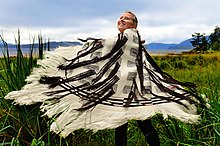
Ravenstail weaving (yeil koowu), also known as Raven's Tail weaving, is a traditional form of geometric weaving-style practiced by Northwest Coast peoples.
History
The practice of Ravenstail and Chilkat weaving originated among the Tsimshian, and was retained by traditional Tlingit and Haida weavers in present-day Alaska. Ravenstail weaving is thought to be a precursor to Chilkat weaving. Ravenstail weaving has sharp, geometric lines and minimal colors; while Chilkat weaving visually looks more natural with curved lines and a larger color palette.
Ravenstail uses a finger-weaving technique called 'twining'. Typically, for Ravenstail pieces, it is created in modern times using black and white (and sometimes yellow) colored merino sheep-wool (sometimes with the traditional slender strands of animal sinew or, a more modern substitute, small amounts of silk) or, when legally available and affordable to the weaver, the original traditional fiber, yarn made from wild mountain goat (Oreamnos americanus) wool, to create bold geometric woven patterns. The early examples, ones made before first contact with foreign explorers and traders who introduced sheep's wool to the continent, were constructed from mountain goat-wool yarn. There are not many surviving historical examples, with roughly a dozen Ravenstail robes in North American and European museums.
Revival
After the 1800s, Ravenstail died out of popularity and due to the rise of new weaving innovations and techniques. The Ravenstail weaving technique almost went extinct after 200 years of inactivity.
Cheryl Samuel was the first person to replicate Ravenstail weaving for revival purposes, and by the mid-1980s she had obtained permission from several Pacific Northwest indigenous tribes to revive the art to regularly teach classes on the subject. In 1987, Samuel published a book The Raven's Tail: Northern Geometric Style Weaving (University of British Columbia Press). In the 1990s additional research was done to bring back the traditional craft; and museums and cultural centers in the Alaskan cities of Juneau, Ketchikan, and Sitka struggled together to revive the craft by working with both Natives and non-Natives. In November 1990, a Ravenstail Weaver's Guild was formed in Ketchikan through the Totem Heritage Center, and served to strengthen craft community between Native and non-Natives in the United States and Canada.
In 2021 the exhibition The Spirit Wraps Around You: Northern Northwest Coast Native Textiles, was held at the Alaska State Museum and included Ravenstail weaving while highlighted the oldest known weavings from Indigenous peoples of the Pacific Northwest Coast.
Notable weavers
- Delores Churchill (Haida)
- Lily Hope (Tlingit)
- Lani Hotch (Tlingit)
- Marie Oldfield (Tsimshian)
- Clarissa Rizal (Tlingit)
- Teri Rofkar (Tlingit)
- Cheryl Samuel (non-Native), the first person to replicate the technique during the revival period.
- Ann Smith (Tlingit/Tutchone)
- Evelyn Vanderhoop (Haida)
See also
References
- ^ Davis, Mary B. (2014-05-01). Native America in the Twentieth Century: An Encyclopedia. Routledge. p. 1771. ISBN 978-1-135-63861-0.
- ^ Neyman, Jenny (March 19, 2016). "Revival of Ravenstail weaving style in good hands". KTOO Public Media.
- ^ Soulé, Barbara (2018-06-29). "Weaving a New Narrative - the Interwoven Radiance Exhibition is Celebrated". Native Arts and Cultures Foundation. Retrieved 2022-07-22.
- ^ Valaskakis, Gail Guthrie; Guimond, Eric; Stout, Madeleine Dion (2011-07-15). Restoring the Balance: First Nations Women, Community, and Culture. Univ. of Manitoba Press. pp. 272, 324. ISBN 978-0-88755-412-4.
- OpenLibrary.org. "The raven's tail (1987 edition) | Open Library". Open Library. Retrieved 2023-05-05.
- OpenLibrary.org. "The raven's tail (1987 edition) | Open Library". Open Library. Retrieved 2023-05-05.
- OpenLibrary.org. "The raven's tail (1987 edition) | Open Library". Open Library. Retrieved 2023-05-05.
- ^ Holm, Bill (2017-01-03). Northwest Coast Indian Art: An Analysis of Form, 50th Anniversary Edition. University of Washington Press. pp. XVII. ISBN 978-0-295-99950-0.
- ^ Segall, Peter (2021-09-21). "Book celebrates historic Ravenstail robe exhibit at state museum". Juneau Empire. Retrieved 2022-07-21.
- "Oldest known Native robes return to Alaska for The Spirit Wraps You exhibit at Alaska State Museum". Alaska Department of Education & Early Development. Retrieved 2022-07-22.
- ^ Meuli, Jonathan (2013-12-19). Shadow House: Interpretations of Northwest Coast Art. Routledge. p. 391. ISBN 978-1-134-43465-7.
- McBride, Rhonda (2021-05-03). ""The Spirit Wraps Around You" at the Alaska State Museum". KTOO. Retrieved 2022-07-22.
- Haakanson, Sven; Steffian, Amy (2016-11-07). Creative Alaska: A Ten-Year Retrospective of Support for Alaska Artists, 2004-2013. University of Alaska Press. p. 16. ISBN 978-1-60223-285-3.
- "Lily Hope: Tlingit Weaver of Chilkat and Ravenstail". Handwoven. Retrieved 2022-07-22.
- ^ "Libraries, Archives, Museums: The Spirit Wraps Around You: Northern Northwest Coast Native Textiles: Home". lam.alaska.gov. Retrieved 2022-07-22.
- Burton, Scott (2016-12-08). "Respected Chilkat and Ravenstail weaver Clarissa Rizal dies at 60". KTOO. Retrieved 2022-07-22.
- Bunn-Marcuse, Kathryn; Jonaitis, Aldona (2020-05-29). Unsettling Native Art Histories on the Northwest Coast. University of Washington Press. p. 244. ISBN 978-0-295-74714-9.
Further reading
- Samuel, Cheryl (1987). The Raven's Tail: Northern Geometric Style Weaving. University of British Columbia Press. ISBN 9780774802246. (which is also available on OpenLibrary.org. "The Raven's Tail (1987 edition)". Open Library.)
- Parker, Kay (2004). Ravenstail Weaving Patterns and Projects, Ancient and Contemporary. Ravenstail Weavers' Guild. Ravenstail Weavers' Guild.
- Henrikson, Steve; Hotch, Lani; Vanderhoop, Evelyn; Oldfield, Marie (2021). The Spirit Wraps Around You: Northern Northwest Coast Native Textiles. Friends of the Alaska State Library, Archives and Museum. ISBN 9781737003618.